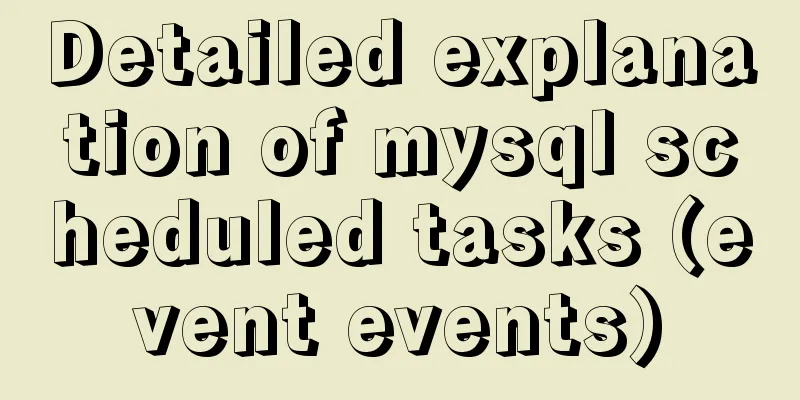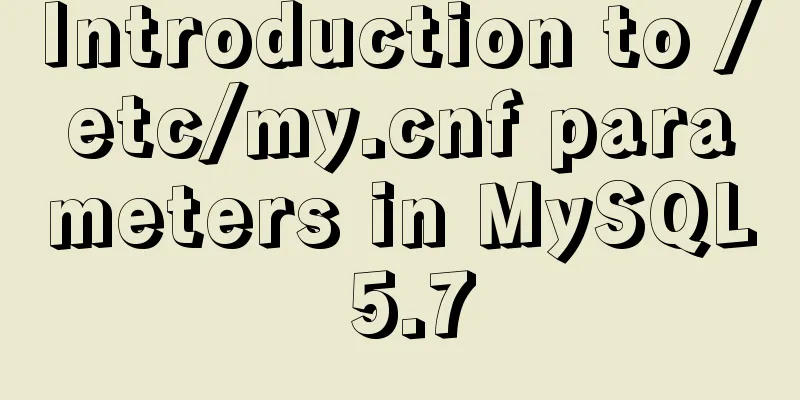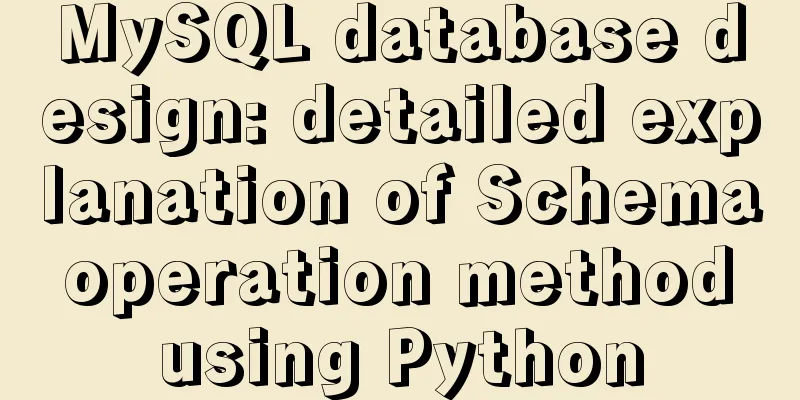Detailed explanation of mysql scheduled tasks (event events)

|
1. Brief introduction of the event An event is a procedural database object that MySQL calls at a specific time. An event can be called once or started periodically. It is managed by a specific thread, the so-called "event scheduler". Events are similar to triggers in that they are triggered when something happens. A trigger is fired when a statement is started on the database, whereas an event is fired based on a scheduled event. Because of their similarity to each other, events are also called temporary triggers. Events replace the work that could previously only be performed by the operating system's scheduled tasks, and MySQL's event scheduler can accurately execute one task per second, while the operating system's scheduled tasks (such as CRON under Linux or task scheduling under Windows) can only be executed once a minute. 2 Advantages and disadvantages of events 2.1 Advantages Some scheduled operations on data no longer rely on external programs, but directly use the functions provided by the database itself. 2.2 Disadvantages Timed trigger, cannot be called. 3 Create events A create event statement creates an event. Each event consists of two main parts. The first part is the event schedule, which indicates when the event is started and at what frequency. The second part is the event action, which is the code executed when the event is triggered. The event action contains a SQL statement, which may be a simple insert or update statement, or a stored procedure or An event can be active (open) or inactive (closed), active means the event scheduler checks if the event action must be called, inactive means the declaration of the event is stored in the catalog but the scheduler does not check if it should be called. After an event is created, it immediately becomes active. An active event can be executed once or multiple times. 3.1 The creation syntax is as follows
CREATE
[DEFINER = { user | CURRENT_USER }]
EVENT
[IF NOT EXISTS]
event_name
ON SCHEDULE schedule
[ON COMPLETION [NOT] PRESERVE]
[ENABLE | DISABLE | DISABLE ON SLAVE]
[COMMENT 'comment']
DO event_body;
schedule:
AT timestamp [+ INTERVAL interval] ...
| EVERY interval
[STARTS timestamp [+ INTERVAL interval] ...]
[ENDS timestamp [+ INTERVAL interval] ...]
interval:
quantity {YEAR | QUARTER | MONTH | DAY | HOUR | MINUTE |
WEEK | SECOND | YEAR_MONTH | DAY_HOUR | DAY_MINUTE |
DAY_SECOND | HOUR_MINUTE | HOUR_SECOND | MINUTE_SECOND} Glossary: event_name: The name of the event to be created (uniquely determined). 3.2 Enable and disable the event scheduler 3.2.1 MySQL event scheduler event_scheduler is responsible for calling events and is closed by default. This scheduler constantly monitors whether an event is to be called. To create an event, the scheduler must be opened. mysql> show variables like '%event_scheduler%'; +-----------------+-------+ | Variable_name | Value | +-----------------+-------+ | event_scheduler | OFF | +-----------------+-------+ 3.2.2 Enable event scheduler Via the command line You can use any of the following command lines SET GLOBAL event_scheduler = ON; SET @@global.event_scheduler = ON; SET GLOBAL event_scheduler = 1; SET @@global.event_scheduler = 1; Through the configuration file my.cnf event_scheduler = 1 #or ON View Scheduler Threads mysql> show processlist; +----+-----------------+-----------+------+---------+------+------------------------+------------------+ | Id | User | Host | db | Command | Time | State | Info | +----+-----------------+-----------+------+---------+------+------------------------+------------------+ | 2 | root | localhost | NULL | Query | 0 | NULL | show processlist | | 3 | event_scheduler | localhost | NULL | Daemon | 6 | Waiting on empty queue | NULL| +----+-----------------+-----------+------+---------+------+------------------------+------------------+ 3.2.3 Turn off the event scheduler Via the command line You can use any of the following command lines SET GLOBAL event_scheduler = OFF; SET @@global.event_scheduler = OFF; SET GLOBAL event_scheduler = 0; SET @@global.event_scheduler = 0; Through the configuration file my.cnf Add under [mysqld] event_scheduler = 0 #or OFF, DISABLED View Scheduler Threads mysql> show processlist; +----+------+-----------+------+---------+------+-------+-----------------+ | Id | User | Host | db | Command | Time | State | Info | +----+------+-----------+------+---------+------+-------+-----------------+ | 2 | root | localhost | NULL | Query | 0 | NULL | show processlist | +----+------+-----------+------+---------+------+-------+-----------------+ 3.3 Example: Create a table to record the name and event stamp of each event dispatch 3.3.1 Create a test table mysql> drop table if exists events_list; mysql> create table events_list(event_name varchar(20) not null, event_started timestamp not null); 3.3.2 Create event 1 (start the event immediately)
create event event_now
on schedule
at now()
do insert into events_list values('event_now', now());View event execution results mysql> select * from events_list; +------------+---------------------+ | event_name | event_started | +------------+---------------------+ | event_now | 2014-07-01 04:06:40 | +------------+---------------------+ 3.3.3 Create event 2 (start an event every minute)
create event test.event_minute
on schedule
every 1 minute
do insert into events_list values('event_now', now());View event execution results mysql> select * from events_list; +------------+---------------------+ | event_name | event_started | +------------+---------------------+ | event_now | 2014-07-01 04:26:53 | | event_now | 2014-07-01 04:27:53 | | event_now | 2014-07-01 04:28:53 | +------------+---------------------+ 3.3.3 Create event 3 (start the event every second) CREATE event event_now ON SCHEDULE EVERY 1 SECOND DO INSERT INTO event_test VALUES(1); 3.3.4 Create event 4 (calling a stored procedure every second) CREATE DEFINER=`root`@`localhost` EVENT `eventUpdateStatus` ON SCHEDULE EVERY 1 SECOND STARTS '2017-11-21 00:12:44' ON COMPLETION PRESERVE ENABLE DO call updateStatus() 3.4 Note: By default, the created event is stored in the current library. You can also display the library in which the specified event is created. You can only view the events created in the current library through show events The event is released after execution. If the event is executed immediately, it will be automatically deleted after execution. You can view the multiple calls or waiting events. If two events need to be called at the same time, MySQL will determine the order in which they are called. If you want to specify the order, you need to ensure that one event is executed at least 1 second after the other event. For recursively scheduled events, the end date cannot be before the start date. A select can be included in an event, but its results disappear, as if it had not been executed. 4 View events View events of the current library mysql> show events; View All Events mysql> select * from mysql.event; The above is the full content of this article. I hope it will be helpful for everyone’s study. I also hope that everyone will support 123WORDPRESS.COM. You may also be interested in:
|
<<: Detailed explanation of the difference between docker-compose ports and expose
>>: How to process local images dynamically loaded in Vue
Recommend
Computed properties and listeners details
Table of contents 1. Calculated properties 1.1 Ba...
What does href=# mean in a link?
Links to the current page. ------------------- Com...
Write a simple calculator using JavaScript
The effect is as follows:Reference Program: <!...
When the interviewer asked the difference between char and varchar in mysql
Table of contents Difference between char and var...
Docker dynamically exposes ports to containers
View the IP address of the Container docker inspe...
Steps to set up HTTPS website based on Nginx
Table of contents Preface: Encryption algorithm: ...
Solution to the problem of the entire page not being centered when using margin:0 auto in HTML
I wrote a jsp page today. I tried to adjust <di...
Let's talk in depth about the principle and implementation of new in JS
Table of contents definition Constructor bodies a...
More than 300 lines of CSS code to achieve the explosive special effects of WeChat 8.0
A major feature of the WeChat 8.0 update is the s...
Detailed explanation of native Javascript inheritance methods and their advantages and disadvantages
Table of contents Preface Prototypal inheritance ...
A small piece of HTML code will include the Baidu search bar in your page
<html> <head> <meta http-equiv=&quo...
Detailed explanation of the adaptive adaptation problem of Vue mobile terminal
1. Create a project with vue ui 2. Select basic c...
Getting Started with MySQL - Concepts
1. What is it? MySQL is the most popular relation...
Understanding Nginx Current Limitation in One Article (Simple Implementation)
Nginx is now one of the most popular load balance...
Set the width of the table to be fixed so that it does not change with the text
After setting the table width in the page to width...









